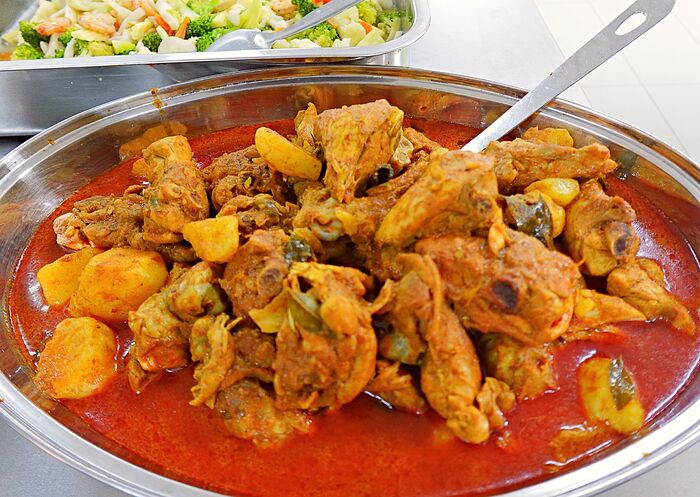Dinner at 1-Michelin-star Auntie Gaik Lean’s Old School Eatery last night. We managed to get a sneak preview of Auntie Gaik Lean’s Chinese New Year menu, which started off with a scrumptious abalone 𝘺𝘦𝘦 𝘴𝘢𝘯𝘨 - our first 𝘭𝘰-𝘩𝘦𝘪 (the traditional tossing of the yee sang) this year, and it’s not even the Year of the Snake yet (Chinese New Year for 2025 will be celebrated in Wed, Jan 29, whence the Year of the Snake will be ushered in, to replace the Year of the Dragon).
Our dinner spread yesterday evening:
- The abalone 𝘺𝘦𝘦 𝘴𝘢𝘯𝘨 consisted entirely of fresh, finely-julienned vegetables - my absolute favourite type of 𝘺𝘦𝘦 𝘴𝘢𝘯𝘨.
The plum sauce dressing for the 𝘺𝘦𝘦 𝘴𝘢𝘯𝘨, plus toasted sesame seeds, crushed groundnuts and cornflakes provided crunch to the mix.
𝘓𝘰 𝘩𝘦𝘪 - the Malaysian/Singaporean Cantonese practice of tossing the 𝘺𝘦𝘦 𝘴𝘢𝘯𝘨.
-
𝘒𝘶𝘦𝘩 𝘱𝘢𝘪 𝘵𝘦𝘦 - these traditional Nyonya pastry cups are adopted from the Indonesian “kue pattie” which, in turn, came from Dutch crispy pastry cups, called “pattie shells” in America when introduced by the Scandinavians in the 1920s. “Pai tee” is a mispronunciation by our local Nyonyas of the American “pattie”.
The filling is similar to the Hokkien filling for popiah, i.e. stewed jicama, carrots, chicken-meat and carrots, topped with scallions and red chilis.
-
𝘖𝘵𝘢𝘬-𝘰𝘵𝘢𝘬 - Penang-Nyonya spicy seafood custard pudding. It’s a local Penang adaption of Siamese 𝘩𝘰𝘳 𝘮𝘰𝘬 𝘵𝘢𝘭𝘢𝘺, and Cambodian 𝘢𝘮𝘰𝘬.
-
𝘕𝘢𝘴𝘪 𝘶𝘭𝘢𝘮 - this is a Penang-Nyonya adaptation of the Siamese (Southern Thai) 𝘬𝘩𝘢𝘰 𝘺𝘢𝘮 rice salad.
-
𝘓𝘰𝘳 𝘣𝘢𝘬 - these are Hokkien 5-spiced meat rolls, known in Hokkien as 𝘯𝘨𝘰𝘳 𝘩𝘪𝘢𝘯𝘨.
The Penang term came from the unique local Penang practice of serving a sticky, brown-hued 5-spiced dipping sauce called “𝘭𝘰𝘳” (similar to the gravy for “𝘭𝘰𝘳 𝘮𝘦𝘦”, a Hokkien noodle dish) with the meat rolls wrapped in beancurd/yuba sheets. “𝘉𝘢𝘬” is the Hokkien word for meat.
Hence, “𝘭𝘰𝘳 𝘣𝘢𝘬” refers to the “𝘭𝘰𝘳” gravy for the “𝘣𝘢𝘬” meat roll. The name stuck, even though 𝗻𝗼 “𝘭𝘰𝘳” gravy is provided with this dish nowadays.
-
Achar awak - Penang-Nyonya pickles, adapted from the Burmese community. In the 19th-century, the Burmese community in Penang was known as Orang Awak, and their settlement in Pulau Tikus was known as Kampung Awak. Hence, the pickles they made and sold at Pulau Tikus market was called Achar Awak.
The Burmese “Awak” was a local mispronunciation of “Ava”, the old Burmese kingdom (1365 to 1555). The Burmese name for the Kingdom is အင်းဝနေပြည်တော် which is equivalent to Ava Kingdom.
-
𝘈𝘴𝘢𝘮 𝘩𝘢𝘦 - tamarind-marinated prawns. The version here is stupendous!
-
𝘑𝘪𝘶 𝘩𝘶 𝘤𝘩𝘢𝘳 - jicama, carrots, and dried cuttlefish.
-
𝘉𝘦𝘦𝘧 𝘳𝘦𝘯𝘥𝘢𝘯𝘨 - very good version here, cooked using Australian Angus beef.
-
𝘊𝘶𝘳𝘳𝘺 𝘒𝘢𝘱𝘪𝘵𝘢𝘯 - Penang-Nyonya chicken curry, replete with lemongrass, fresh turmeric, chilis and kaffir lime leaves. Its use of fresh 𝘳𝘦𝘮𝘱𝘢𝘩 (spice mix) instead of dry spices betrays its Thai origins.
-
Crisp-fried garoupa with soy-chili dressing. This sea creature was so big, it looked like something the Nautilus would’ve encountered 20,000 leagues under the sea.
Absolutely delish, and a must-order.
-
𝘎𝘶𝘭𝘢𝘪 𝘵𝘶𝘮𝘪𝘴 - this dish is a not part of the Chinese New Year menu, but an item on Auntie Gaik Lean’s regular menu, a house specialty and a must-order.
-
𝘕𝘺𝘰𝘯𝘺𝘢 𝘤𝘩𝘢𝘱 𝘤𝘩𝘺𝘦. The local “chap chye” shares a common origin as American-Chinese “chop suey”, but with a much lighter taste profile, with the vegetables here given a quick stir-fry.
-
𝘒𝘪𝘢𝘮 𝘤𝘩𝘺𝘦 𝘢𝘳𝘬 - duck and salted mustard soup (known as 𝘪𝘵𝘪𝘬 𝘵𝘪𝘮 in Melaka/Singapore-Nyonya cooking).
-
Giant freshwater prawns in spicy-chili dressing.
Desserts:
16) 𝘉𝘦𝘦 𝘬𝘰𝘩 𝘮𝘰𝘺 - black glutinous rice cooked with dried longans, coconut milk and sugar (known as 𝘱𝘶𝘭𝘶𝘵 𝘩𝘪𝘵𝘢𝘮 in Melaka/Singapore-Nyonya cooking).
- 𝘗𝘦𝘯𝘨𝘢𝘵 - bananas (only 𝘗𝘪𝘴𝘢𝘯𝘨 𝘙𝘢𝘫𝘢 specie) and a selection of yellow, orange and purple sweet potatoes in coconut milk and sugar, scented with pandan.
Fab meal with some really good cooking. The vibe at Auntie Gaik Lean’s Old School Eatery is almost unparalleled in George Town, with a constant train of local and foreign customers, many queuing outside.
More about Auntie Gaik Lean here:
Address
Auntie Gaik Lean’s Old School Eatery
1, Bishop Street, 10200 George Town, Penang, Malaysia
Tel: +6017-434 4398
Opening hours: 12pm-2.30pm, 6pm-9.30pm Wed to Sun. Closed on Mondays and Tuesdays.





















































